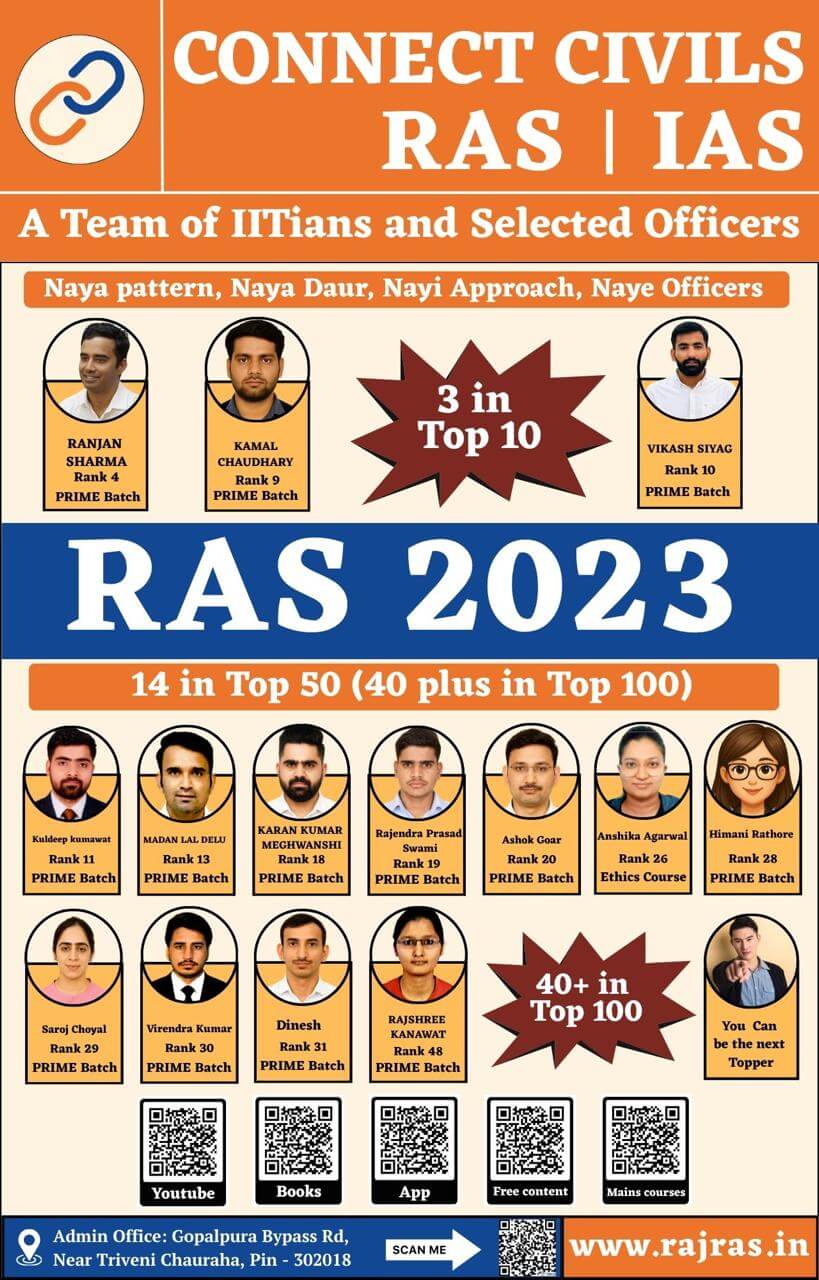The Folk Arts of Rajasthan are a vibrant expression of its cultural heritage and traditional lifestyle. In Rajasthan History, these art forms ranging from music and dance to painting and puppetry reflect the creativity, devotion, and daily life of its people. Rajasthani folk art has been divided into following types:
- Wall & ground paintings: Devra, Pathwari, Sanjhi , Mandav etc.
- Cloth Paintings: Pat, Pichhwai, Phad etc
- Painting on Paper: Paane
- Painting made on Wood: Kavad
- Painting on Human body: Mehandi, Godana
Rajasthani Paintings
Rajasthan has a rich tradition of painting, with various schools flourishing over time. Paintings were created on diverse surfaces like paper, cloth, temple walls, and havelis. The earliest evidence of painting in Rajasthan includes primitive rock drawings found at Alnia, Dara (Kota), Bairath (Jaipur), Dar-Barahna (Bharatpur), Chambal, Kalisindh valleys, as well as Mount Abu and the Aravallis.
Rajasthani painting originated around 1500 A.D. in Medpat (Mewar), influenced by the Ajanta School. In the beginning, Rajasthani painting exhibits influences of the Jain, Gujarat and Apabhramsa styles, but later on, it came to be influenced more and more by the Mughal style. The earliest available example of illustrated text is Audh Niryukti Vritti and Das Vaitalika Sutra Choorni (1060 AD)
Scholars and Terminology :
- Rajput Art : Mr. Brown, Smith, G. A. Greyerson, G. Thomas.
- Rajput Style : Anand Kumar Swami (1916).
- Hindu Style : H.C. Mehta, Narsirao.
- Rajasthani Style : Ramkrishna Das, Col. James Tod, G.S. Ojha.
Development of Rajasthani Paintings :
- 12th Century: Jain Style, also known as Apbransh Shaili by Rai Krishandas.
- 15th Century: Emergence as an independent art form.
- 18th Century: Golden Era of Rajasthani Paintings.
- Mewar is recognized as the birthplace of Rajasthani Paintings.
Key Features:
- Themes & Features:
- Nature personification, vibrant use of primary and dark colors.
- Common themes: godly depictions, hunting scenes, Raagmala, Barahmaasa, and societal life.
- Mughal Influence:
- Use of transparent clothing and detailed subject matter.
- Folk & Cultural Life:
- Rich depictions of folk life, focusing on bhakti (devotion) and shringar (romance).
- Visibility:
- Seen on palace, fort, temple, and haveli walls.
- Aesthetic Identity:
- Vivid portrayal of natural and feminine beauty gives distinct identity.
- Patronage:
- Supported by rulers, princes, and feudal lords.
- The amatory (singarik) depiction of seasons and their impact on human life.
Techniques and Materials
- Miniature Paintings: Executed on handmade paper with natural colors derived from minerals, vegetables, and precious stones.
- Murals : Created on walls using wet plaster techniques like ala gilla and morakasi.
- Manikuttim : Use of pearls and lacquer.
Rajasthani Painting have been classified under four subcategories on geographical and cultural basis :
- Mewar School: Chavand style, Udaipur style, Nathdwara style, Deogarh sub style, Savar sub style, Shahpura substyle and art of thikanas like Banera, Bagore, Begun and Kelwa.
- Marwar School : Jodhpur style, Bikaner style, Kishangarh style, Ajmer style, Nagore style, Sirohi style, Jaisalmer style and thikana styles of Ghanerao, Riyan, Bhinay and Juniyan.
- Hadoti School: Bundi style, Kota style, Jhalawar sub style.
- Dhundhar School : Amer style, Jaipur style, Shekhawati style, Alwar style, Uniara sub-style and thikana art of Jhilai, Isarda, Shahpura, Samod.
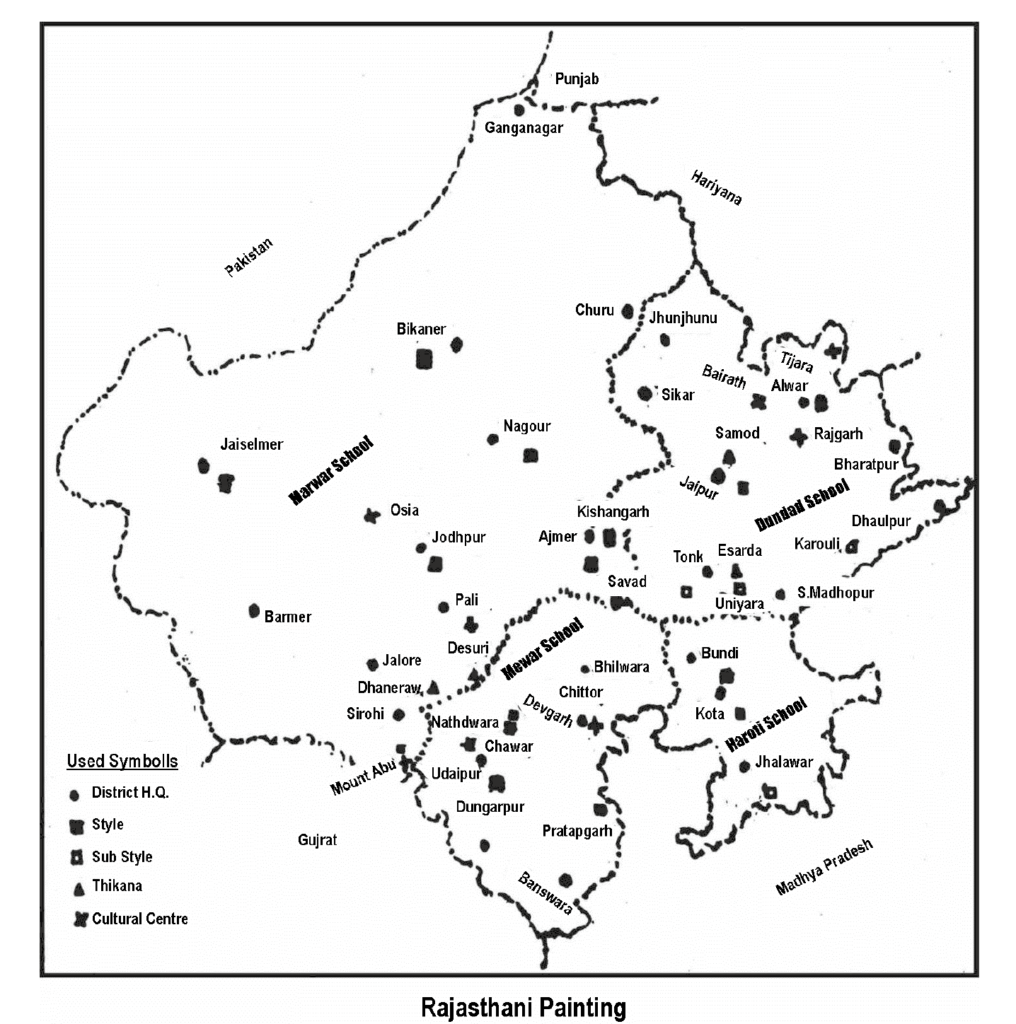
Mewar School :

- Early and indigenous styles of Rajasthani painting can be seen in the Mewar school.
- Early Period: Began with illustrations for Pothi texts, e.g., Shravak Pratikraman Sutra Choorni (1260 A.D) during Tej Singh’s reign.
- Golden Era: Under Maharana Kumbha, a peak in artistic development.
- Important Works: Parijat Avtaran (Bhagwat Purana) during Udai Singh’s reign (1535-1572), Dhola Maru (1592) during Maharana Pratap in his capital chawand.
- Later Developments: Ragmala during Maharana Amar Singh I, and works by painters like Sahabdin and Manohar under Rana Jagat Singh I (golden era of miniature art).
- Themes: Rasikpriya, Geet Govind, Bhagwat Puran, Ramayana.
Udaipur Style/Chwand style
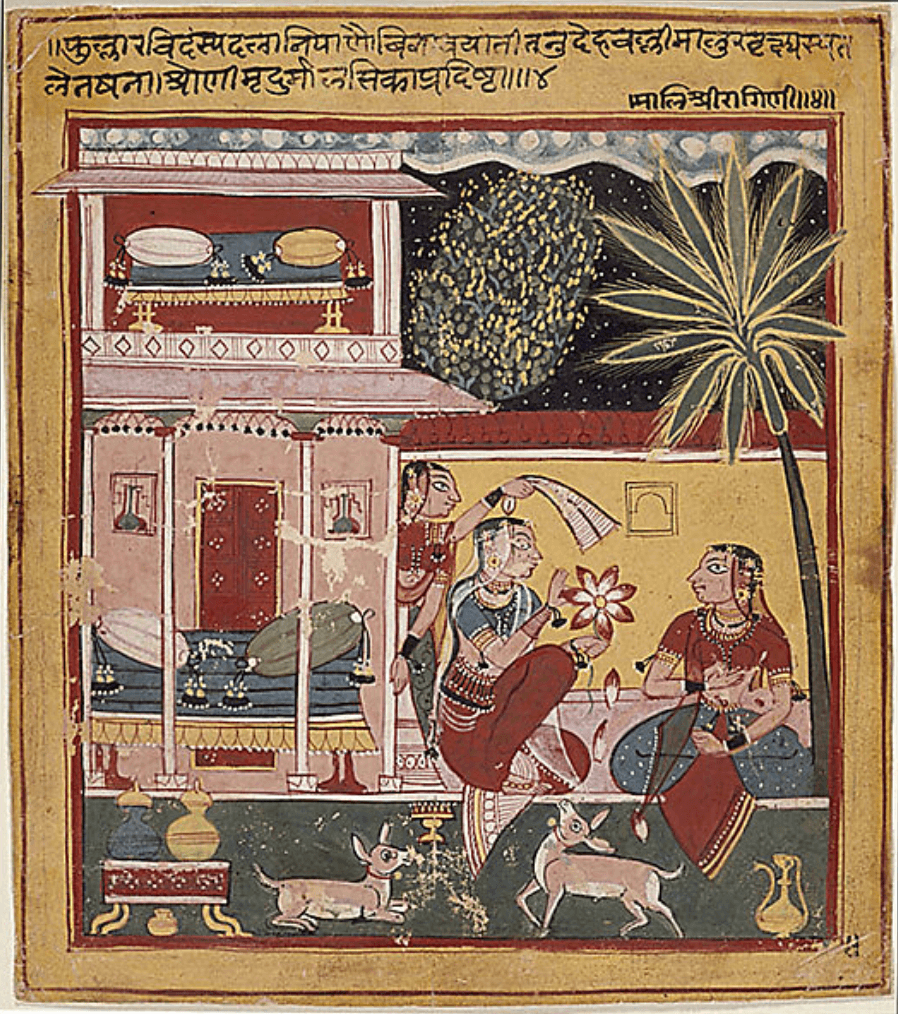
- This style flourished during the reign of Maharana Pratap when Chawand became his capital.
- The reign of Maharana Jagat Singh I (1628-1652) is considered the golden era of this style.
- Miniature paintings based on themes such as Rasikpriya, Geet Govind, Bhagwat Purana, and Ramayana were created.
- Prominent painters: Sahabdin, Manohar, Kriparam, Umra, Kamalchand, Bhikhmachand.
- Maharana Jagat Singh established a picture gallery in the Udaipur palace named ‘Chiteron ki Ovari’ ( Tasveera ro karkhano ).
- During the reign of Maharana Sangram Singh II, paintings were created on themes like Geet Govind, Bihari Satsai, Sundar Shringar, Mulla Do Pyaza’s Satirical Tales(Latife) , and Kalila-Damna (Panchatantra).
Features:
- Male Figures: Sturdy build, moustached faces, large eyes, open lips, short neck, short height, Udaipuri turban, and long headdresses.
- Female Figures: Simplicity, fish-shaped eyes, sharp straight nose, double chin, short stature, wearing lugdi-ghagra, adorned with typical Rajasthani jewelry.
- Nature: Balanced and aesthetically appealing depiction of natural surroundings.
- Colors: Dominance of red and yellow hues.
Nathdwara Style
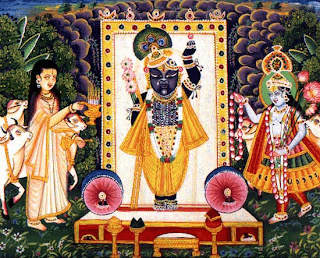
- This is the second significant phase of Mewar School, a fusion of Udaipur and Braj styles.
- Pichhwai paintings [painting done on large cloth pieces hung behind the idol of Shrinathji for the purpose of decoration], were a hallmark of this style.
- These paintings vividly depict Krishna’s legends, featuring characters like Yashoda, Nand, Gopis, and saints of the Vallabh sect.
- Dominant colors: Green and Yellow.
- Prominent painters: Baba Ramchandra, Narayan, Chaturbhuj, Ramling, Champalal, Tulsiram.
- Notable female painters: Kamala and Ilaichi.
Features:
- Main Subjects: Central image of Shrinathji, herds of cows, deities depicted in the sky, and banana trees in the background.
- Background: Dense vegetation and celestial depictions.
Deogarh Style
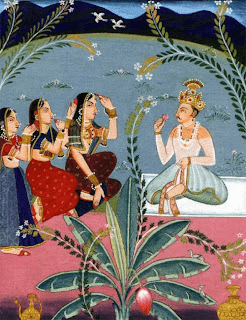
- Deogarh Thikana was founded by Dwarikadas Chundawat in 1680 A.D during the reign of Maharana Jai Singh.
- This style is a fusion of Mewar, Marwar, and Jaipur styles.
- Deogarh style was first brought to light by Dr Sridhar Andhare.
- Wall paintings from this style adorn structures like ‘Ajara ki Auvri‘ and ‘Moti Mahal’.
- Prominent painters: Bagta, Kanwala, Harchand Nanga, Chokha, Baijnath.
Features:
- Themes: Natural landscapes, hunting scenes, royal processions, and harem life.
- Fusion Style: A balanced blend of three major regional styles.
- Natural Depiction: Lush surroundings and intricate portrayal of scenes.
Marwar School :
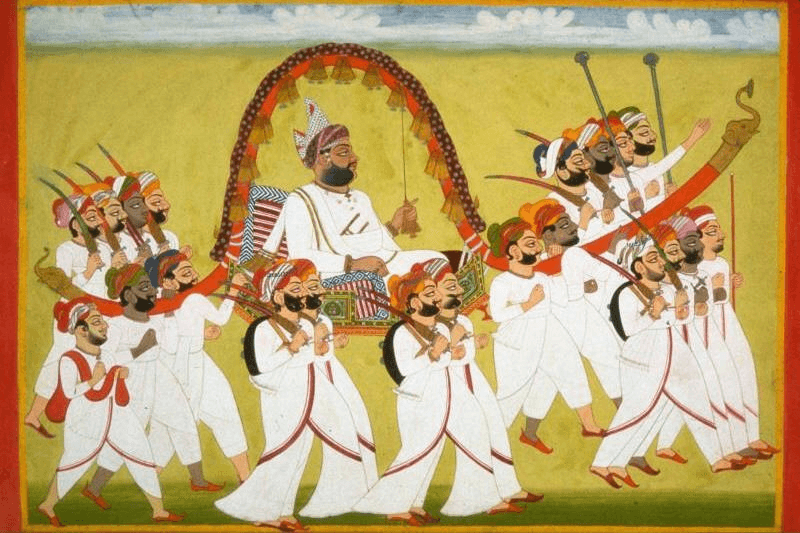
- Early remnants of this style are found in Audh Niyukti Vritti from the Pratihara period.
- Tibetan historian Lama Taranath mentions Sharangdhar, a 7th-century painter from Maru Desh, who founded the Yaksha Style in Western India.
- Geographical Influence: Flourished in Jodhpur, Bikaner, Kishangarh, Nagaur, and Ajmer .
- The paintings often depict romantic tales from Marwari literature i.e, Dhola-Maru, Mumal-Mahendra, Rupmati-Baj bahadur.
Jodhpur School
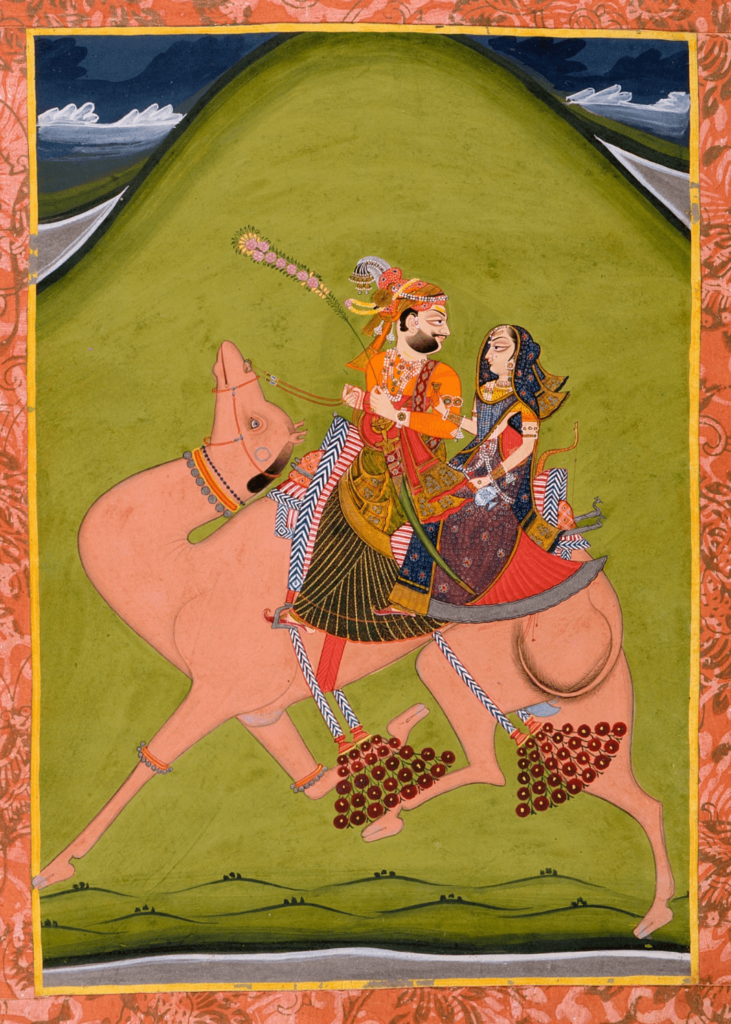
- Maharaja Maldev: Initiated art patronage, with early works in Chokhelav Mahal and Uttaradhyayana Sutra.
- 1610 AD: A Bhagwat manuscript was created combining Mewar and Marwar styles.
- 1623 AD: Veerji painted Ragmala Chitravali for Pali’s hero, Vithaldas Champawat.
- Maharaja Jaswant Singh’s Era: Influenced by Krishna legends and Mughal art.
- Maharaja Man Singh: Patron of Nath sect art; prominent artists like Dana Bhati, Shiv das, Shankar das, Madho das, Amar das flourished during his reign.
- Prominent painters: Amar Das Bhati, Dana Bhati, Shankar Das, Madho Das, Ram Singh Bhati -and Shiv Das.
Features:
- Themes: Romance of Dhola-Maru, Mumal – Mahendra, and Rupmati-Baj Bahadur.
- Figures:
- Men: Tall, strong, curled whiskers, high turbans, ornaments and attire displaying royal splendour.
- Women: Lehenga, odhani with red tassels.
- Unique Features: Almond-shaped eyes, lofty turbans, dominance of red and yellow colors, natural surroundings.
Bikaner Style
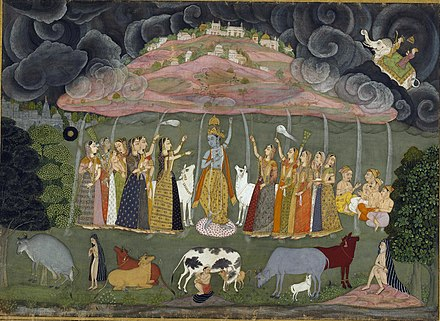
- Originated towards the 10th century, with Rao Rai Singh bringing Mughal artists like Ustad Ali Raza and Hamid Ruknuddin.
- Contributors: Matherna family (Jain and Rajasthani styles) and Usta family (Mughal style, Usta paintings on camel pelt with gold).
- Golden Era: During Anup Singh’s reign; painters like Ram Lal, Ali Raja, and Hasan depicted Hindu themes and Sanskrit texts.
- Prominent painters: Ustad Ali Raza, Ustad Hamid Ruknuddin, Ram Lal, Ali Raja and Hasan.
Features:
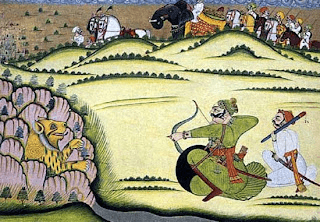
- Fusion of Mughal and local Rajasthani elements.
- Figures:
- Females: Slim, delicate, eyes resembling those of deer, painted in blue, red, and violet.
- Males: High Shahjahan-Aurangzeb style turbans.
- Unique images: Saras-Mithun (crane couple) under rain clouds, court scenes, fountains.
Kishangarh School
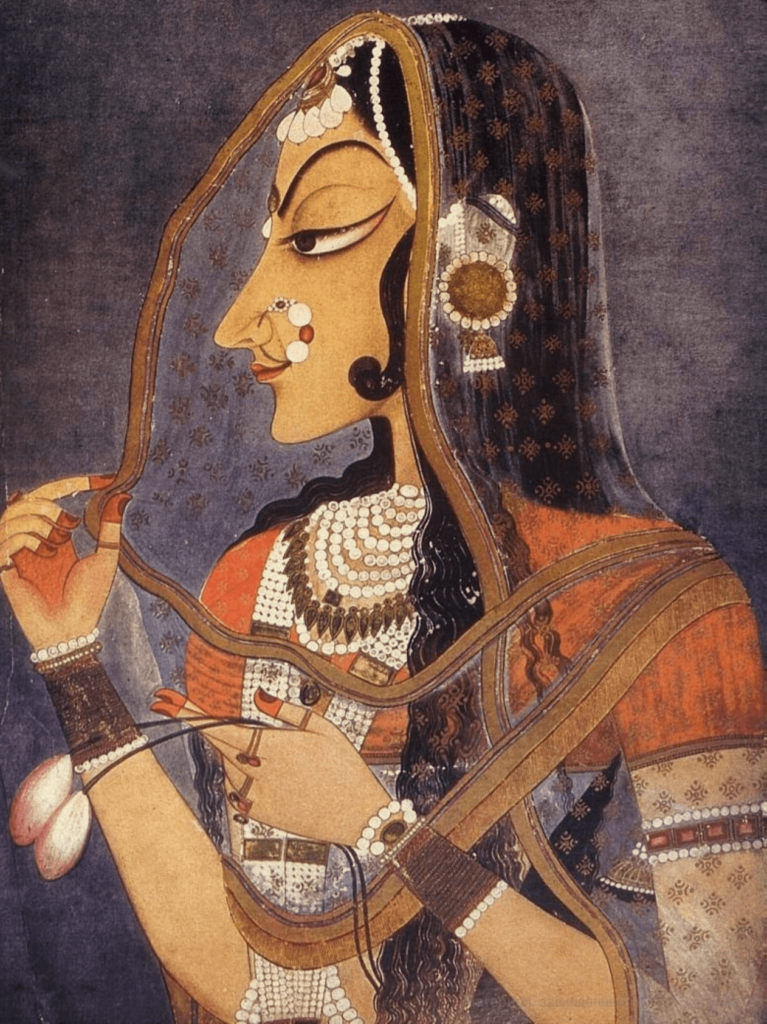
- Founded in 1609 AD by Raja Kishan Singh.
- Patronized by the royal family following the Vallabh sect of Bhakti tradition.
- The period of Raja Sawant Singh (1748-1764 AD) is considered to be the golden age of Kishangarh style. Sawant Singh was famous for the nickname of Nagaridas. Sawant Singh himself was a good painter.
- His court painter Mordhwaj Nihalchand took the Kishangarh style to the highest level by painting ‘Bani-Thani’ (Nagridas’s lover).
- Nihalchand has depicted Bani-Thani as Radha, who is shown holding a lotus flower in her hand.
- Bani-Thani has been called the Monalisa of India by Eric Dickinson. In 1973, the Government of India issued a 20 paise postage stamp on Bani Thani.
- ‘Chandni Raat Ki Sangeet Goshti’ is the second famous painting of Kishangarh style painted by Amarchand.
- The credit for bringing this style to light goes to Eric Dickinson and Faiyaz Ali.
- Prominent painters: Nanakram, Sitaram, Surdhwaj, Mulraj, Mordwaj Nihal Chand, Badan Singh, Ramnath, Sawairam and Laladi Das.
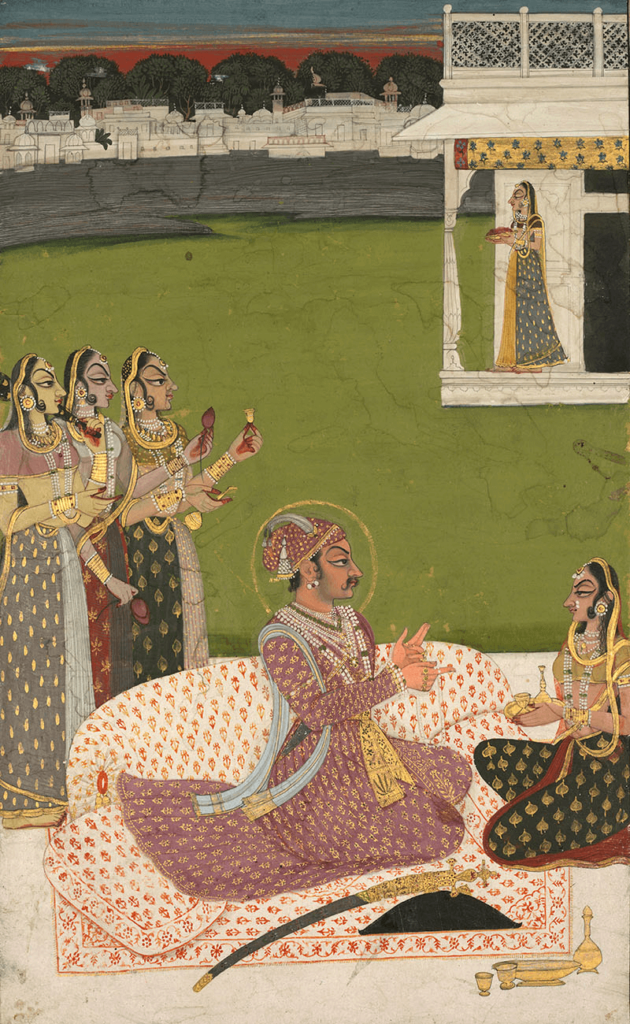
Features:
- Distinct Faces: Sharp and elongated facial features with pointed noses, curved chins, half-closed eyes, and serpentine hair.
- Themes: Krishna-Radha lila in vast landscapes, frolicking swans, moonlit amorous scenes.
- Colors: White, pink, grey, vermillion.
Ajmer School
- Blend of Feudal and Folk Culture: Dominated by rural and Rajput influences.
- Prominent Thikanas: Bhinaya, Sawar, Masuda, Junia.
- Famous painters include Chand, Tayyab, Ramsingh Bhati, Jalji, Narayan and Madhoji.
- Unique Work: Chand’s portrait of Raja Pabuji (1698 AD).
Nagaur Style
- Nagaur style is a subgenre influenced by the Marwar School of painting.
- Key Features:
- Prominent in painted wooden doors and frescoes on fort walls.
- Known for its depiction of ‘old age’ themes, use of faded colours and transparent attire, a unique characteristic.
Jaisalmer School
- Originated mainly during the reigns of Maharawal Harraj, Akhai Singh, and Mulraj.
- Uniqueness: Jaisalmer’s art remained completely local, uninfluenced by Mughal or Jodhpur styles.
- Key Painting: Mumal is the representative artwork, reflecting the distinct local style of the region.
Ghanerao Style
- Ghanerao is a Thikana situated south of Jodhpur.
- Artists: Narayan, Chhajju, and Kriparam were the prominent painters of this style
Hadoti School :
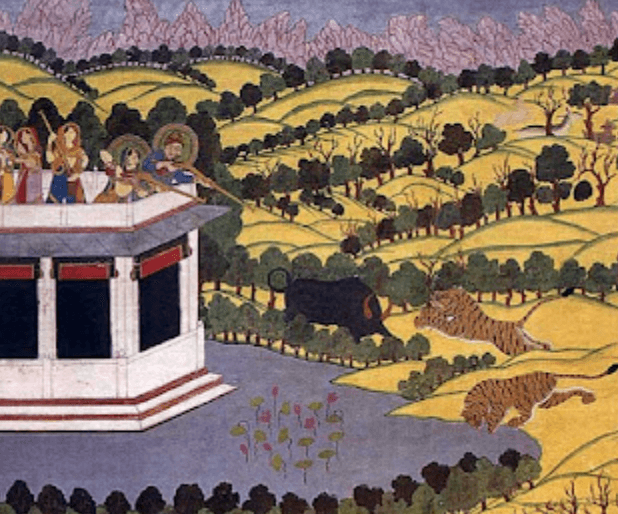
- Region: Includes Bundi, Kota, and Jhalawar, named after the Hadas, a branch of the Chauhan dynasty.
Bundi Sytle
- Initially, the Bundi style was influenced by the Mewar School. Later, during Rao Surjan Singh’s reign, it was influenced by the Mughal style.
- Flourished during the reign of Rao Shatrushal (Chhatrasal). He built the famous Rangmahal murals (Bhitti Chitra).
- Rao Ummed Singh constructed the ‘Chitrashala’ and brought a new turn to the style. This chitrashala is called ‘heaven of wall paintings’.

Key Features

- Depiction of flora, fauna, multi-coloured clouds, and lakes.
- Background: Hills, wild animals, rivers, birds, peacocks, monkeys, and vibrant flowers.
- Themes include – Ragamala, Baramasa, Bhagawat Purana, Rasikapriya miniatures, Krishna Lila, court scenes, hunting scenes, festivals, and elephant fights.
- Ummed Singh hunting a wild boar (1750 AD) is a well-known painting of this school.
- Female figures:
- Tall, slender, narrow-waisted with almond-shaped eyes, pointed nose, deep red lips, small chins and reddish-brown skin tone.
- Dressed in colourful ghagra, translucent odhni, and short choli.
- Predominant colours: Pink, red, and green.
- Prominent painters: Surjan, Ahmad Ali, Ramlal, Shri Kisan, and Sadhuram.
Kota School
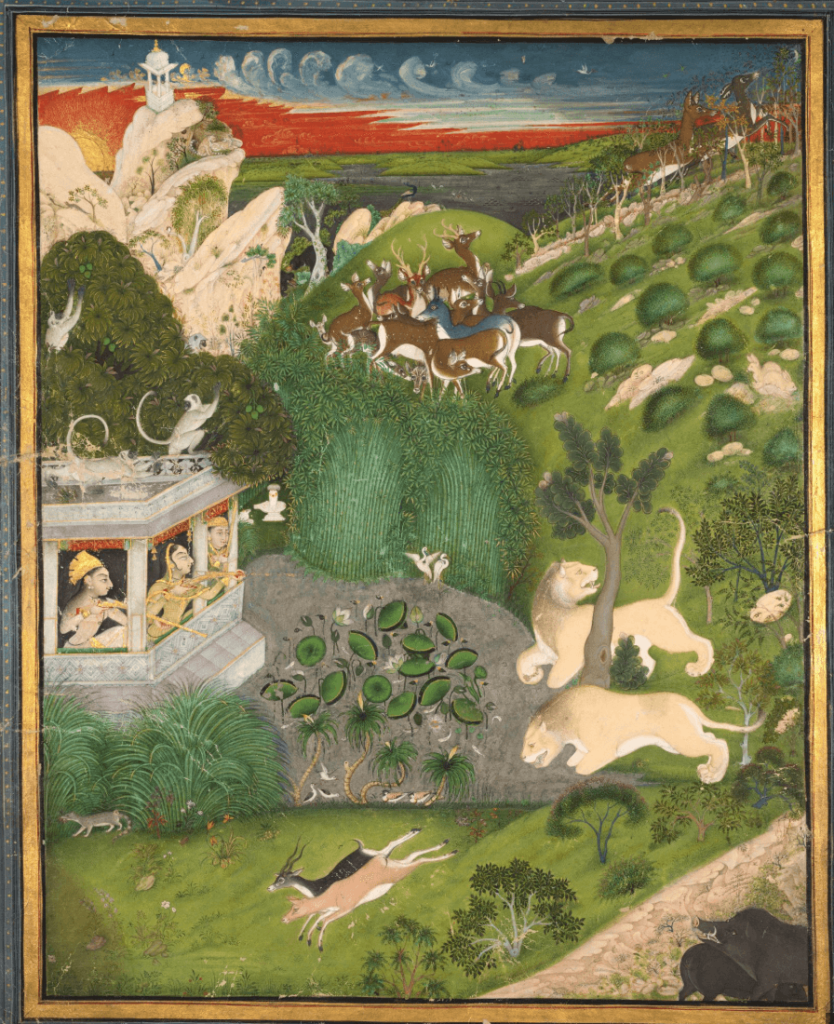
- Established as an independent genre by Maharao Ram Singh (1661-1705 AD).
- Kota painting achieved its zenith during the reign of Ummed Singh.
- Hunting scenes in dazzling colours became the hallmark, with depictions of queens and ladies hunting.
Key features:
- Female Figures: Lustrous cheeks, long locks of hair, corpulent lips, and slender waist.
- Male Figures: Muscular bodies, broad shoulders, moustaches, and bejeweled attire.
- Colours: Predominantly light green, yellow, and blue.
- Famous Painters: Raghunath, Govindram, Dalu, Lachhiram, and Nur Muhammad.
Difference between Bundi & Kota school of paintings
| Feature | Bundi Style | Kota Style |
| Period of Origin | Started during the reign of Rao Surjan Singh | Originated under Rao Ram Singh |
| Golden Period | Reign of Rao Chhatrasal | Reign of Maharaja Ummed Singh |
| Nature of Paintings | Delicate, lyrical, and poetic; emphasis on soft, natural elements | Bold, dynamic, and vibrant with dramatic compositions |
| Influences | Strong influence of Mewar School | A blend of Mewar, Mughal, and Deccan styles |
| Themes | Nature-centric themes: Baramasa, Ragmala, Radha-Krishna Lilas, courtly love scenes, and hunting | Action-oriented themes: Hunting scenes, battles, royal processions, and courtly grandeur |
| Color Palette | Muted and pastel shades; fine detailing of flora and fauna | Bright and rich colors; emphasis on bold strokes |
| Special Features | Representation of rains and forests with lush greenery | Depictions of tigers, wild animals, and hunting scenes |
| Prominent Figures | Radha-Krishna, Nayak-Nayika, and saints | Royals, warriors, and hunters |
| Famous painters | Surjan, Ahmad Ali, Ramlal, Shri Kisan, and Sadhuram. | Raghunath, Govindram, Dalu, Lachchhiram, and Nur Muhammad. |
Jhalawar Style
- Themes: Wall paintings in palaces depict Shrinathji, Radha-Krishna lila, Ramlila, and royal grandeur.
Dhundhar school :
Amer style
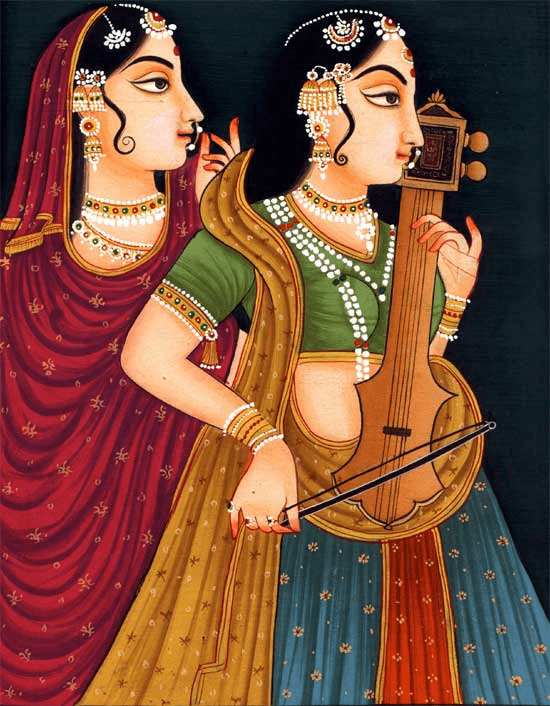
- Amber style of painting began to develop in the reign of Man singh ji.
- The Yashodhara Charitra (1591 AD) is the most prominent text illustrated in the early Amber style.
- An illustrated copy of Razmnama (1588 AD) was prepared in the Suratkhana of Amber for Emperor Akbar, containing 169 large-sized paintings, some by Jaipur artists.
- Early murals have been discovered at Bairath and Mauzamabad, particularly in the so-called Mughal Garden, reflecting strong Mughal influences.
- Second Phase of Amber Style begun during the reign of Mirza Raja Jai Singh
- He got the illustrated volumes of Rasikapriya and Krishna Rukmani ri Veli prepared for his queen Chandrawati
Jaipur style
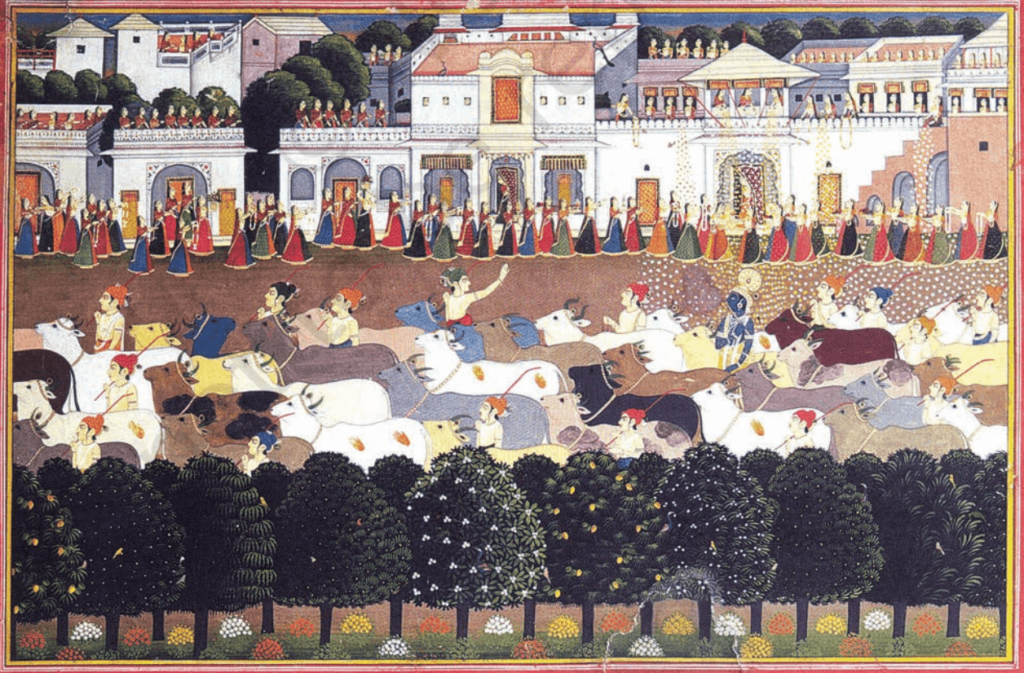
- Jaipur’s painting style is the result of the gradual development of Amer’s style of painting. Sawai Jai Singh-I had established ’36 karkhanas (departments) in Amer, among which was ‘Surat Khana’, where paintings were done.
- Expanded under rulers like Sawai Ishwari Singh, Sawai Madho Singh I, and Sawai Pratap Singh.
- Ishwari singh – suratkhana moved from amer to jaipur.
- Sahibram painted life sized painting of Sawai ishwari singh
- Madho singh – Encouraged the ‘Manikuttim trend’ of ornamentation during the Ritikāl period.
Manikuttam style – instead of filling the pictures with colours, designs are created by pasting pearls, lac and wooden beads.
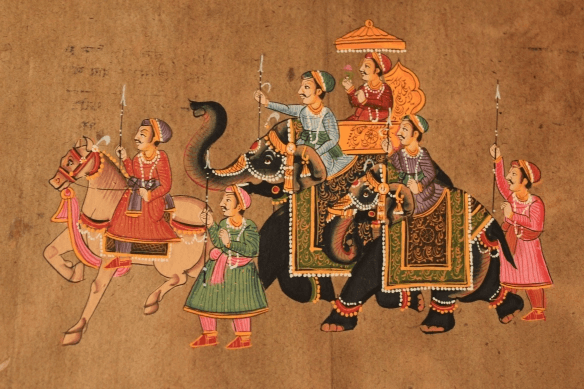
- Reign of Sawai Pratap singh is considered to be the Golden age of Jaipur school of paintings.
- During his time, more than 50 artists were employed in Surat Khana, among whom Ramsevak, Hukma, Chimna, Laxman, Saligram etc were prominent.
- Maharaja Sawai Ram Singh established ‘Maharaja School of Arts and Crafts‘ (Hunri Madrasa) in 1857 AD for the development of art, which is currently known as ‘Rajasthan School of arts.
Artistic Features:
- Themes: Radha-Krishna Lilas, Naika-bhed, Ragmala, Baramasa, animal fights, and court scenes, Women offering alms to a fakir, princesses reading Quran, life size portrait and miniature painting, Gardens of char-bag style.
- Style: A blend of Mughal and Rajput art, retaining grace and folk elements.
- Prominent Artists: Sahibram, Lalchand, Ramsewak, Gopal, and Hukama.
- Significant Contributions:
- The Jaipur artists introduced the tradition of life-sized portraits and murals.
- The Ala-Gilla / Araish / Morakasi method was first used in Rajasthan by the Jaipur School artists in Amber.
Ala-Gilla mural technique : In this method, first lime was ground to a fine smooth powder, then it was plastered on the wall and on this wet plaster painting was done with colour dissolved in water. The wet lime plaster absorbs the colour and the painting becomes the integral part of the wall.
Alwar Style
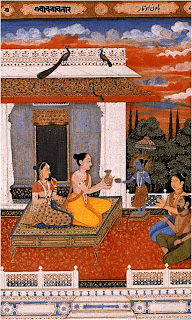
- Foundation:
- Originated in 1775 AD under Rao Raja Pratap Singh, influenced by Jaipur School.
- Prominent painters Shivkumar and Daluram came from Jaipur.
- The wall paintings in the Shish Mahal of Alwar, done during Bakhtawar Singh’s reign, marked the beginning of the Alwar Style.
- Vinay Singh’s reign is known to be the Golden time of Alwar paintings. He is compared to the mughal emperor Akbar in this regard.
- Production of a calligraphed and illustrated volume of Gulistan is a unique event of his reign.
- In the reign of Maharaja Mangal Singh, Mulchand and Udairam did some fine, exquisite painting on ivory plaques
- Key Features:
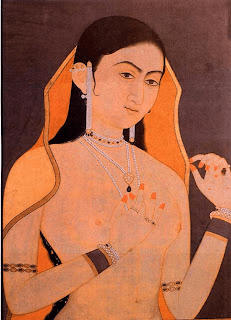
- Fusion of Iranian, Mughal, and Rajasthani styles.
- Themes: Erotic love, discussions with Nathas and Fakirs, Gulistan illustrations, miniatures, and portraits.
- Pictures of prostitutes are a unique feature of Alwar paintings.
- The creation of beautiful floral designs and the use of golden colour are the distinctive features of the Alwar style.
- Distinct depiction of female figures with raised braids and floral designs.
- Fine painting on ivory blades.
- Famous painters: Shivkumar, Baldev, Ramgopal, Ramsahay Nepalia, Nandram, Saligram and Chotelal.
Uniara Style
- Developed under the Naruka dynasty of Uniara.
- Patronized by Raoraja Sardar Singh.
- Themes: Influenced by Bundi and Jaipur Schools, depicting Ram, Sita, Lakshman, and Hanuman.
- Prominent Painters: Dheema, Mirbaksa, Kashi, Ramlakhan, and Bhim.
Shekhawati Murals
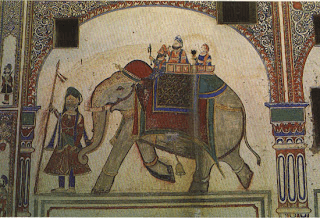
- Jaipur style wall painting has had the greatest influence on Shekhawati.
- Equite mural work of this style can be seen on the havelis of Nawalgarh, Ramgarh, Fatehpur, Laxmangarh, Mukundgarh, Mandawa, and Bisau.
- Key Features:
- Murals painted on inner and outer walls.
- Themes: Big elephants and horses, domestic life(curd churning, cow milking), myths and legends, Ragmala, gods and demons, saints, and ascetics, Folk tales, mythology, and erotic scenes.
- Colors Predominantly Used: Catechu, blue, and pink.
- Known as the Open Art Gallery of Rajasthan.
Fine Arts of Rajasthan
Thape:
- Thape is a form of drawings on walls.
- In Rajasthan it is made up of turmeric, geru, henna and kumkum.
- Pictures are drawn on the both side of the door, to invoke deities, Prevalent in Rajasthan
Badaley
- In Jodhpur, metal utensils used for drinking water have a layer of cloth or leather wrapped around them. These are called Badaley.
- They are provided with beautiful designs & colors.
Thewa Art
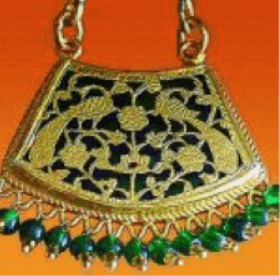
- Thewa art is minute painting on glass using gold.
- Glass used is colored Belgium glass.
- Different colors are used to make it attractive
- The art is limited to Pratapgarh
Mandana Art
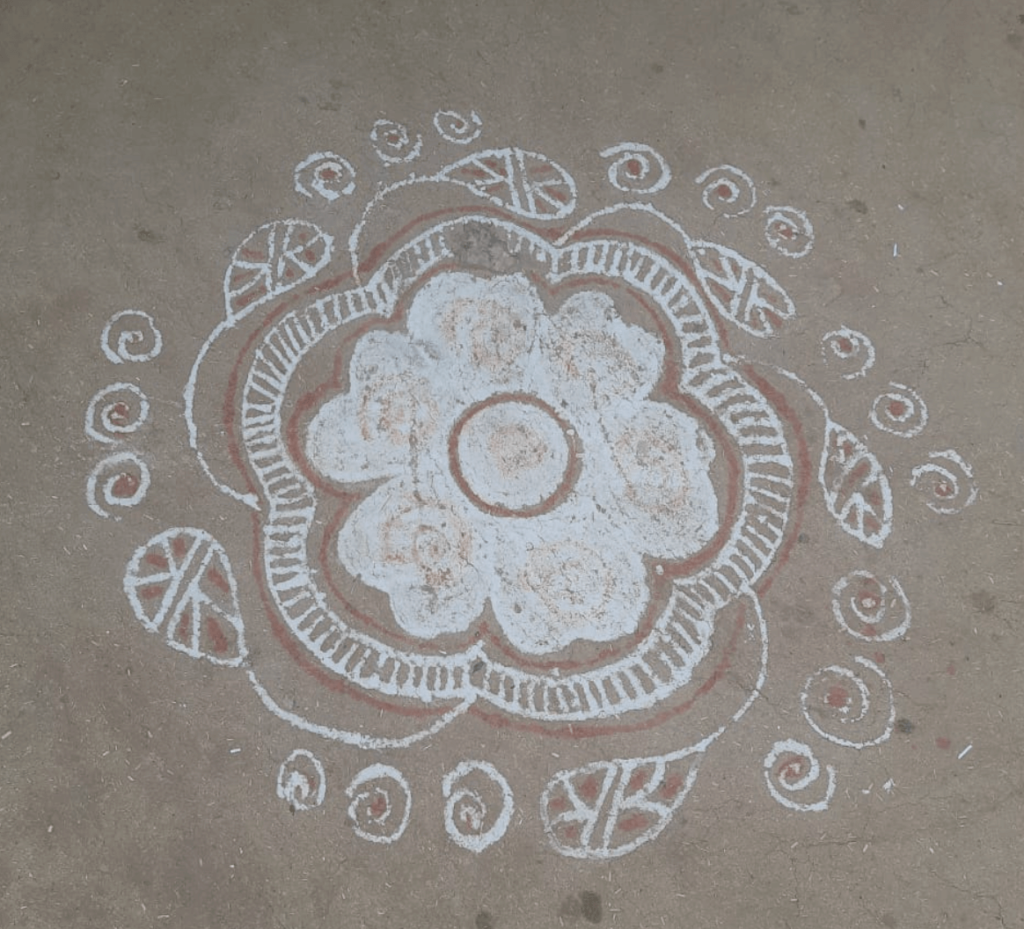
- Mandana is an art of the tribal wall and floor paintings found in Rajasthan and Madhya Pradesh
- It is derived from the word ‘Mandan’ referring to decoration and beautification and comprises simple geometric forms like triangles, squares and circles to decorate houses.
- In tribal ideology they are famed for warding off evil and acting as a good luck charm.
- It uses white khariya or chalk solution and geru or red ochre.
- The design may show Ganesha, peacocks, women at work, tigers, floral motifs, etc
Phad
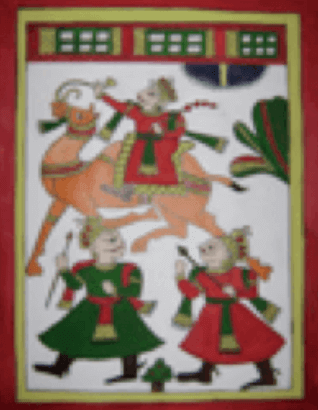
- Phad is a painted scroll, which depicts stories of epic dimensions about local deities and legendary heroes.
- Bhopas (local priests) carry these scrolls on their shoulders from village to village for a performance Represents the moving shrine of the deity and is an object of worship.
- Most popular & largest Phad – local deities Devnarayanji and Pabuji.
- Shahpura, Tehsil in Bhilwara is famous for Phad.
- 2006, Shri laal Joshi – was awarded Padamshri for contribution to Phad.
Pane
- Pictures of gods and goddesses made on paper are called “Pāne.”
- These are used during festivals and special occasions in Rajasthan.
- Made on plain paper using poster colors.
Wooden Art – Kavad

- A small temple-like wooden structure with many doors.
- Paintings are made on the doors, which are opened one by one during storytelling.
- When all doors are open, idols of Ram, Lakshman, and Sita are seen.
- Painted red, with mythological stories drawn in black.
- Bassi village in Chittorgarh is famous for making Kāvad.
Bewan
- A wooden temple that is open from the front and closed on three sides.
Sanjhi

- Made during the dark fortnight of the lunar month (Badh Paksha).
- Girls carve shapes on whitewashed walls using cow dung.
- The shapes represent Goddess Parvati, and girls pray for a good husband and home.
Godna (Tattooing)
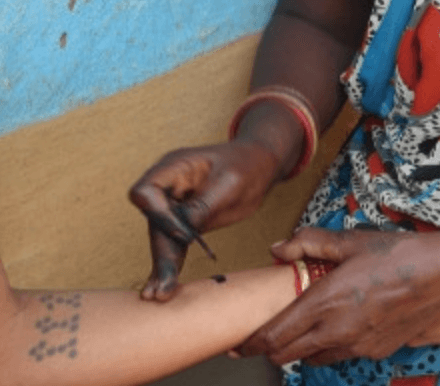
- Tattoos made by piercing the skin with a sharp tool and filling it with black ink.
- Common among women of communities like Ahir, Guwari, Gujjar, Rebari, Sansi, Bhambi, Kasai, Banjara, Khatik, and Kalbeliya.
Veel
- Common in rural areas of Western Rajasthan.
- Made of wicker and clay mixed with horse-dung.
- Features many shelves and compartments of different sizes.
- Beautified with alcoves (Gavaksh), mesh (jaalis), and crenels (kangoore) adorned with small mirror pieces.
- Used both as a showpiece and a showcase.
Kothian

- Kothis are storage structures in rural areas.
- Made of clay and decorated with jalis (ventilators), ornamental crenels (kangoore), and paintings of gods, goddesses, animals, foliage, and mandanas.
Kathputli (Puppets)

- An ancient and popular form of theatre in Rajasthan.
- Puppets carved out of wood and controlled by strings.
- Kathputli is Rajasthan’s contribution to global art and entertainment.
- Traditional performances include ballads from tales like Singhasan Battisi, romances like Prithviraj-Sanyogita, and heroics of Amar Singh Rathore.
- Kathputli artists of the Bhartiya Lok Kala Mandal won the first prize at the Third International Puppet Festival in Bucharest, Romania, 1965
FAQ (Previous year questions)
2016 special exam)
Similarities :
Religious Themes: Both Bundi and Kishangarh schools emphasized Krishna Lila and Ragamala. Bundi featured Bhagawat Purana and Rasikapriya, while Kishangarh focused on Krishna-Radha lila.
Vibrant Colors: Both used bright colors—Bundi with pink, red, and green; Kishangarh with white, pink, grey, and vermillion.
Nature: Both richly portrayed nature, including flowers, birds, animals, and landscapes. Kishangarh emphasized moonlit landscapes and swans.
Differences :
Aspect
Bundi School
Kishangarh School
Patronage
Flourished under Rao Shatrushal & Rao Ummed Singh
Patronized by Raja Sawant Singh and royal family
Influence
Initially Mewar, later Mughal
Bhakti tradition, Vallabh sect
Mural paintings
Present – Chitrashala
Not specifically
Female facial features
Elongated faces, arched eyebrows, and lotus-like eyes
Round faces, receding foreheads, and full cheeks
Famous painters
Surjan, Ahmad Ali, Ramlal
Mordhwaj Nihalchand, Nanakram, Sitaram
This style is a fusion of Udaipur and Braj styles.
Theme: These paintings vividly depict Krishna’s legends, featuring characters like Yashoda, Nand, Gopis, and saints of the Vallabh sect.
Dominant colors: Green and Yellow.
Background: Dense vegetation and celestial depictions.
Pichhwai paintings were a hallmark of this style.
Sawai Jai Singh II (1688–1743) was a visionary ruler of Jaipur, renowned for his contributions to architecture, art, and literature.
Promotion of Artistic Excellence: Established the ‘Suratkhana’ painting department, fostering artistic creativity and providing employment opportunities for artisans, enhancing Jaipur’s cultural landscape.
Literary Contributions: Authored the “Jai Singh Karika” in 1701, a significant work reflecting his scholarly engagement with astrology and astronomy, contributing to intellectual discourse.
Patronage of Scholars: Supported eminent scholars like Pundarik Ratnakar, Pandit Jagannath, Kevalram, Nayan Chandra Mukherjee, and Muhammad Mehri, creating a vibrant intellectual environment in his court.
Architectural Artistry: Founded Jaipur in 1727, designed by Vidyadhar Bhattacharya based on Shilpa Shastra, blending Mughal and Rajput architectural styles. Notable structures include City Palace (with Chandra Mahal), Jaigarh Fort, Nahargarh Fort, and the iconic Jal Mahal.
Religious and Cultural Art: Commissioned the statue of Lord Kalki and built temples like Govind Dev Ji, temples in Mathura, Govardhan, and Kalki Temple in Sirh Deori Bazaar, reflecting his commitment to preserving Hindu cultural and artistic traditions.
Astronomical Legacy: Constructed the Jaipur Observatory (Jantar Mantar) in 1728, a masterpiece of scientific architecture, recognized as a UNESCO World Heritage Site, blending art, science, and culture.

